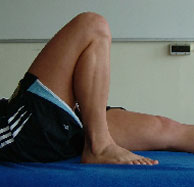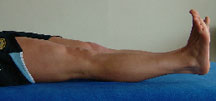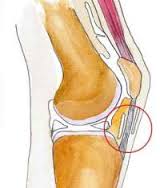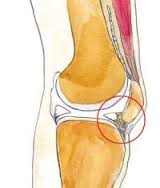Some unfortunate knee patients find their progress with rehabilitation frustrated by issues related to adhesions and scarring inside the knee cavity.
This can happen to anyone, but in a particular group of people who seem to form an aggressive type of scar tissue their lives are turned upside down as they struggle to find the right people to help them.
Our readers have raised many issues on the forum, of which a few include -
- What is the normal range of movement of the knee, and what are the MUA and CPM trying to achieve?
- How can a meniscus op end up with the patella becoming stuck down?
- Why are serial lateral X-rays of the patella relevant to the discussion about arthrofibrosis?
- Why do some people seem to form a more aggressive kind of arthrofibrotic scarring than others?
- At what point in knee rehab might a person feel that they may be 'joining the AF club'?
Let's look at these in a bit more detail -
What is the normal range of movement of the knee, and what are the MUA and CPM trying to achieve?
 |
normal flexion |
 |
normal extension |
Dr Noyes has published that the normal ROM is usually minus 5 to 143 degrees in women and usually minus 6 to 140 degrees in men (Ref). [The 'minus' numbers reflect the fact that most people can bend their knee a little bit backwards.]
After surgery, it is almost inevitable that the range of movement will decrease. There may be a reduction in the bending amount (flexion) or in the straightening amount (extension) or both. This happens for a number of reasons:
- The knee may be painful from the surgery
- There may be blood or fluid in the knee, physically preventing its range of movement
- The quads muscle may be inhibited, which frequently occurs after an insult to the knee
- There may be sticky strands or adhesions in various places in and around the knee, preventing the tissues from moving in relation to one another
How can a meniscus op end up with the patella becoming stuck down?
The meniscus does not have a lot to do with all this. Any surgical procedure to the knee, including knee replacement, can end up with adhesions around the patella.
Think for a moment about what happens when you bend your knee. Sure, the bones move in relation to one another, but there are soft tissue structures that have to move as well. There are several layers of soft tissues, separated at key areas by lubricating 'envelopes' - suck around your mouth and open and close your teeth, and you get an idea of the lubricating tissues that allow this. Imagine if sticky adhesive bands stuck the area inside your lips to your gums!
This little video, prepared for another part of this site, illustrates the issue -
Why are serial lateral X-rays of the patella relevant to the discussion about arthrofibrosis?
The following two illustrations show how the patella gets passively tugged downwards as the scar tissue develops and contracts in the soft tissues under and around the patella.
 |
Side view of the normal knee showing some of the bursae (lubricating envelopes). Note the normal position of the patella. |
 |
Same view when the envelopes are stuck down with scar tissue, pulling the patella downwards. Note that the patella is now a patella infera (or baja). |
This gradual downward drift can be picked up by the vigilant doctor who is carefully monitoring the problematic patient. The doctor can then pro-actively intervene to break adhesions, keep the knee moving and calm the inflammation down.
Why do some people seem to form a more aggressive kind of arthrofibrotic scarring than others?
Some situations tend to trigger more aggressive scar formation - bleeding into the joint, multiple surgical procedures, infection after surgery or injury. But there seems also to be a particular kind of person who is prone to a florid form of arthrofibrosis in the absence of these triggers.
Research is beginning to point to a genetic anomaly which could be screened for1.
At what point in knee rehab might a person feel that they may be 'joining the AF club'?
If after the 6-week stage, rehab seems to fail to make progress, or things seem to be getting worse, then keep this diagnosis in mind.
Knee stiffness, out of proportion to the expected, knee pain, out of proportion to the expected, a hot knee, out of proportion to the expected - then start to talk to your doctor about this.
References
1. Open Orthop J. 2012;6:199-203. doi: 10.2174/1874325001206010199. Epub 2012 May 16. BMP-2 Dependent Increase of Soft Tissue Density in Arthrofibrotic TKA. Pfitzner T, Röhner E, Krenn V, Perka C, Matziolis G.
